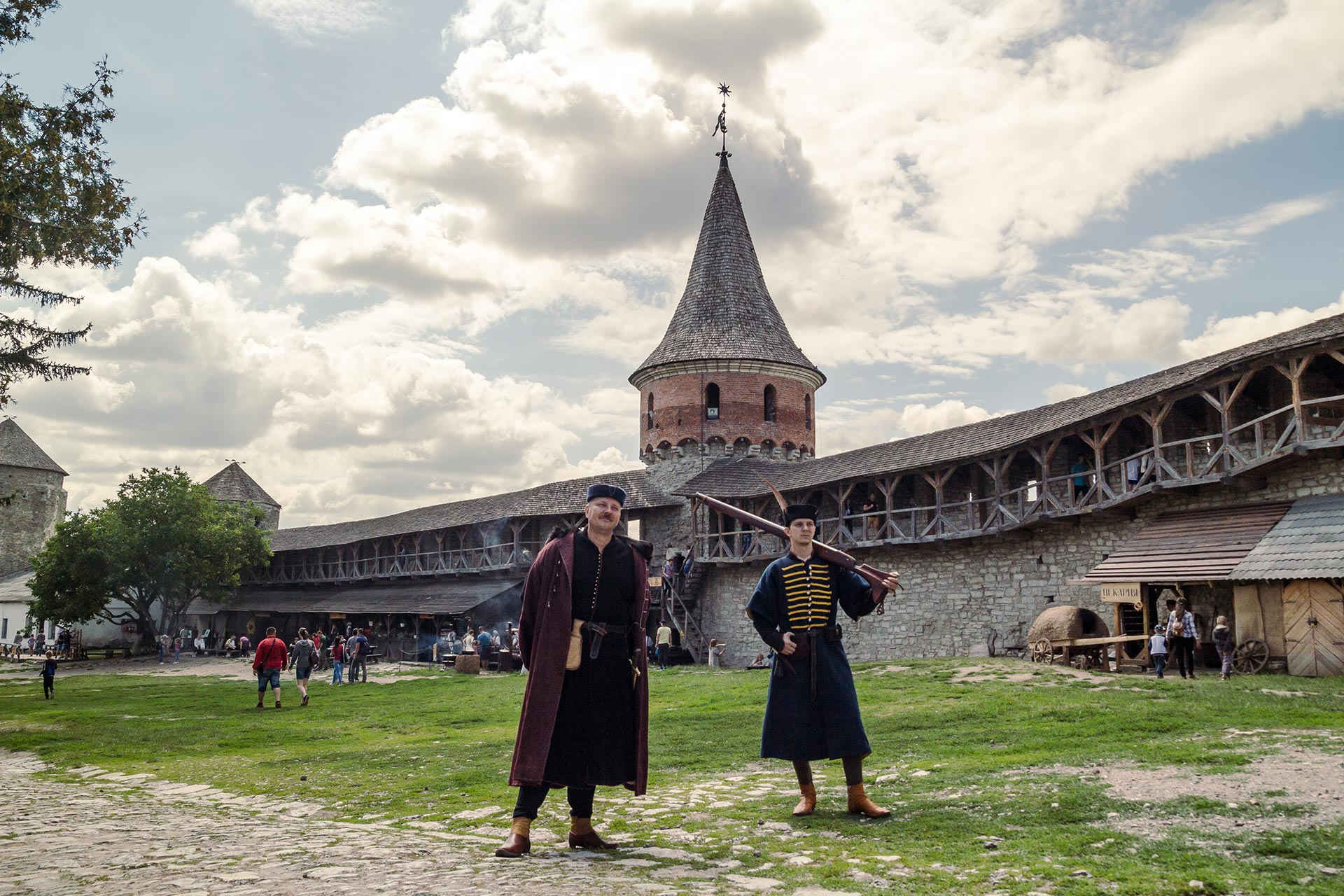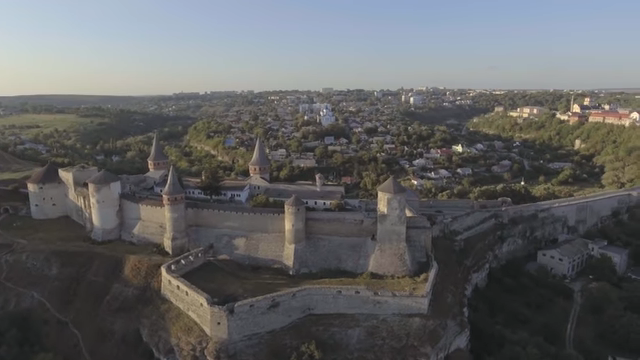-
Read also: Five historic сastles to visit in Ukraine

Historical reconstruction is the process of recreation of a culture of its epoch and region. To achieve this, researchers read archives, look through pictures, and analyze archeological findings. Through scientific experiments and gaming techniques, the recreators – experimental archaeologists – come as close as possible to the primary look of the things or traditions of the epoch being researched.
The public organization Kamianets-Podilskyi City Military and Historical Community has been around for 20 years now. It includes all of the recreators of Kamianets-Podilskyi fortress. Its members are engaged in studying and popularizing history, mainly the past of Podillia and Kamianets-Podilskyi.The fortress’s director, Oleksandr Zaremba, believes that they must talk about the city as much as possible, for it served as the last capital of the Ukrainian National Republic, [a short-lived Ukrainian independent state that emerged in 1917 – Ed].In 1919-1920, Kamianets-Podilskyi found itself in a position previously held by [previous capitals] Kharkiv and Kyiv for some time. As a matter of fact, the eponymous festival, “The Last Capital”, is held annually in August.
“Imagine the stereotypes of an early twenty-first-century person, whenever they hear something about Kozaks. No doubt they would think of a guy in red high boots, wide trousers (sharovary) and an embroidered shirt. We want to change this stereotype a little bit and show that there’s more to Ukrainians than this,” says Oleksandr Zaremba, the director of Kamianets-Podilskyi fortress, who is into XVII century military and historical reenactment. Oleksandr says that the biggest problem in reenactment lies in the absence of a clear understanding of how to work. He believes that the opportunity for tourism and education to change cities and regions isn’t obvious to Ukrainians. Together with his colleagues, he runs the School of Reenactment project, sharing trends and opportunities, as well as encouraging people to join the effort. The Living Fortress project was launched in the fortress six years ago. As part of it, craftsmen would show off their crafts, hold masterclasses, and perform reenactments. According to Oleksandr, the number of tourists has grown almost tenfold over the past 20 years. Given this popularity of a tourist attraction, museum researchers care more about the prosperity of the fortress and its actual reconstruction. Rain and slope erosion cause the deterioration of castle walls. However, the work goes on, as tourists come to Kamianets-Podilskyi and expect a living history brought to life. Ihor Chesnivsky partakes in the seventeenth-century reenactment. With his colleagues, he makes traditional bows of that period, recreates garments, and educates people. Ukraine doesn’t have mass events that delve into traditional archery and popularize this art and sport. However, Ihor is one of the organizers of the annual international traditional archery tournament “Stone Arrow” in Kamianets-Podilskyi. In a sense, the city itself inspires such endeavors. Ihor talks a lot about Turkish, Tatar, and European traditions of making bows. Now and then, he’ll mention Ukrainian traditions too, but stops immediately. Kozaks mostly used bows not of their own making, and archeological findings support that. Scythian bows survive until the present day, but they can hardly be called a Ukrainian tradition. Six years ago, Oleh Shulyk baked his first loaf of bread. Initiated by the senior reenactor, Oleksandr Zaremba, an idea to try something new and show it to the tourists came about. Having assembled a stove, they set to work. They burned their first loaves, however. The bread is baked from second rate flour. Oleg doesn’t like the idea of using premium flour, because it turns bread-making into a much too simple and mundane procedure. This is how it goes: in the correct order, we mix either whey or sour milk, sugar, rye flour, and let the dough ferment. The dough should be kneaded for an hour. The fortress has a water mill that has been used to grind grain a couple of times. Oleg believes that this is another interesting tourist attraction that brings many visitors to the fortress. This grain would later be used to bake bread. However, the water mill, like many other elements of the fortress, requires maintenance. Oleh Shulyk, the baker, joined the reenactment community after he met another Oleh, the potter. Together with his friends, they wore traditional XVII-century costumes, which drew attention to them. At first, he couldn’t believe his luck in running into them, as it was one of his dreams. Later, he couldn’t believe that joining the reenactment effort was this simple: buy homespun cloth, cut it to size and shape and sew a garment. No additional knowledge or skills required. Oleh Khrapan. Photo: Ukrainer.net Oleh Khrapan is a potter. He has his own workshop in one of the rooms of the fortress, where he organizes masterclasses for kids and adults and sells pottery. He provides all of the necessary materials to tourists and asks for one thing only: a desire to create something new and interesting. Previously, Oleh’s workshop was situated in the canyon next to Ruska Brama — another old settlement, but farther out from the fortress. Few people travel there, and hardly anybody would drop by the place. The craftsman got bored and decided to move to the fortress. Pots are produced in several stages. The clay that potters buy is as solid as a stone, and it doesn’t work well for pottery. It has to be soaked, brought to the consistency of sour cream, passed through a sieve, dried on the shelves and, when it’s dry enough, kneaded. The job is half done at this point. The next step is actual molding and baking. A potter continuously wets his hands with water so that the clay will stay malleable and rotates the pottery wheel with his foot. Clay can acquire nearly any form. Ornaments are made with special tools, although a wooden stick is the most common one. To remove a pot or a jug from the pottery wheel without causing any damage, it will be cut using a thread.
The fortress is surrounded by a canyon, at the bottom of which flows the river Smotrych. Rounding the island as a loop, it creates incredible scenery.Due to this favorable location, the Kamianets-Podilskyi fortress is considered to be one of the most impregnable fortresses on the territory of modern Ukraine. It was taken only twice in history — a fact that gives the Kamianets-Podilskyi residents great pride in their past.
Re-enactment


Bow-making and archery


Baking


Pottery



Read more:
- Five historic сastles to visit in Ukraine
- The seven wonders of Ukraine
- Travel to Ukraine online — a tourist guide for quarantine times
- Russia methodically destroys and removes cultural treasures from occupied Crimea
- Meet the activists saving unique stone “embroidery” on Soviet-era houses


